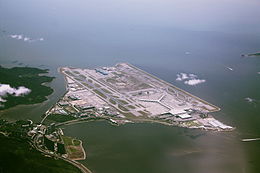Chek Lap Kok
| 赤鱲角 | |
|---|---|

Aerial view of the airport island in 2010.
|
|
| Location of Chek Lap Kok in Hong Kong. | |
| Geography | |
| Location | North of Lantau Island |
| Coordinates | 22°18′19.1″N 113°55′18.6″E / 22.305306°N 113.921833°ECoordinates: 22°18′19.1″N 113°55′18.6″E / 22.305306°N 113.921833°E |
| Area | 3.02 km2 (1.17 sq mi) |
| Length | 4 km (2.5 mi) |
| Administration | |
| Chek Lap Kok | |||||||||||||||
| Traditional Chinese | 赤鱲角 | ||||||||||||||
|---|---|---|---|---|---|---|---|---|---|---|---|---|---|---|---|
| Simplified Chinese | 赤鱲角 | ||||||||||||||
| Literal meaning | Red Perch Cape | ||||||||||||||
|
|||||||||||||||
| Transcriptions | |
|---|---|
| Standard Mandarin | |
| Hanyu Pinyin | Chì liè Jiǎo |
| Yue: Cantonese | |
| Yale Romanization | Chek laahp gok |
| IPA | [tsʰɛ̄ːk làːp kɔ̄ːk] |
| Jyutping | Cek3 laap6 gok3 |
Chek Lap Kok is an island in the western waters of Hong Kong. Together with the smaller Lam Chau, it was leveled and merged via land reclamation into the 12.48 square kilometres (4.82 sq mi) island for the current Hong Kong International Airport, which opened for commercial aviation in 1998. The airport is therefore popularly referred to as Chek Lap Kok Airport.
Hong Kong SkyCity, a business and entertainment complex, is also located on Chek Lap Kok. It includes AsiaWorld-Expo, a convention and exhibition centre, which opened in 2005. Cathay Pacific City, the head office of Cathay Pacific, and the head offices of Dragonair and Hong Kong Airlines are also located on the airport platform.
The name of the island may be derived from the bareness of the island ('da chek lak'), that the shape of the island resembles the red tripletail Perch ('chek lap', 赤鱲), or that the fish was once abundant in its vicinity.
The island is located north of Lantau Island off Ma Wan Chung and Tung Chung. Before the building of the airport platform, it was a small and hilly island, about 4 kilometres (2.5 mi) long, with an area of 3.02 square kilometres (1.17 sq mi) (other sources mention 2.8 square kilometres (1.1 sq mi)). The southern end of the island formed a small peninsula, which has been left largely undeveloped. This area is facing Tung Chung and is now named "Scenic Hill". It is the site of the Ancient Kiln Park and the Airport Island Angle Station of the Ngong Ping 360 cable car.
The island has been inhabited on and off since the Middle Neolithic period 6,000 years ago.
During the 19th and 20th centuries, the inhabitants of the island practiced farming, including rice cultivation, and quarrying. Their population was about 200 in the 1950s, raising sharply in the 1960s. It later declined, with some 20 families remaining on the island when the plan for the construction of a new airport was announced in the early 1990s.
...
Wikipedia

